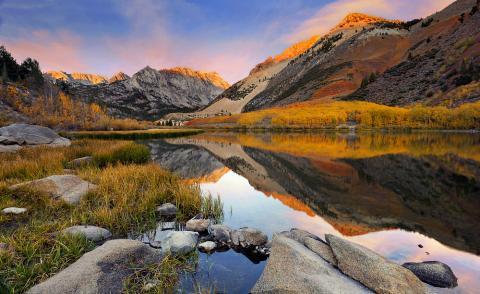
When I’m sad and at a loss for what to do, I’ll often head to the high country outside of Durango, Colorado. If my energy is too low to wander in the woods, I may simply park in a pull-off to sit and “check in” with Twilight Peak or Engineer Mountain. Nothing like a giant rock that’s been there for tens of millions of years for a bit of perspective and support.
Believe it or not, this is an official form of therapy called “Nature Therapy.” In Japan, Shinrin-Yoku, or “Forest Bathing,” is practiced, which involves being in nature and dropping out of one’s head and into the five senses. It can be difficult, if not impossible, for most of us to turn off our thoughts. Rather, the idea is to simply let them pass without getting sucked into them, while plugging into our surroundings.
What are the benefits of being in nature?
Multiple research studies have found what those of us who get out into nature on a regular basis already know: being in nature makes us feel better. For example, studies have shown that Forest Bathing benefits heart function, stress response, and depression. But there is also a general sense of wellbeing that happens when we recognize that we are, in fact, part of nature…by getting outside.
Part of the benefit that comes from being in nature is, of course, visual. Seeing the beauty around you can help put day-to-day life into perspective, if only during your time in the woods, desert, park, or wherever. And the benefits from literally looking at nature go beyond the appreciation of beauty. The movement of your eyes as you take in the scenery, along with the play of light if you happen to be walking through dappled shade, have a significant effect on nervous system wiring. Take EMDR (Eye Movement Desensitization and Reprocessing), for example. It’s a groundbreaking therapy for helping the brain to push through “stuck processing” of past trauma, and was developed by Dr. Francine Shapiro while she was walking in a park. She noticed that the unpleasant line of thinking she was experiencing ceased as her eyes took in her surroundings and when she later went back to the same line of thought, the thoughts felt less charged.
Here’s a guided approach to getting you in touch with your senses whether you’re in the woods, in a meadow, in the desert or, really, anywhere in nature….Even if you’re stuck inside somewhere, you can use the following questions to do some Nature Therapy in your imagination. Or out on a fire escape or balcony or stoop.
How to Try Nature Therapy Anywhere
1. What do you see?
When outside, “drop in,” whether you prefer movement down a trail or sitting on a rock or under a tree or on an overlook. Notice what you see. Take the whole scene in and also notice the details around you, however small. Colors, textures, movement, stillness. Notice this for a while. If you’re stuck in a city, then take in your surroundings. Any trees along the street? Any persistent plants coming up through the cracks in the sidewalk? Any sunlight reflecting off the buildings or clouds passing overhead?
2. What do you hear?
Then switch to what you hear. Sound meditation is a great practice for being in nature or wherever you are. Do you hear a stream flowing, or a waterfall crashing, or the whoosh of the wind through the pines? To me, the wind through pines sounds like the ocean, while through aspen leaves it sounds like a stream. Do you hear any animals? Birds or maybe some four-footed critters scurrying through the leaves? Or maybe the special softening of sound that happens when it snows? My favorite sound is the sound of water flowing under the surface of a frozen stream. If in an urban area, what natural sounds can you hear? Birds? Wind? Leaves blowing along the sidewalk?
3. What do you feel?
Switch to what you feel. Are you warm or cold? Is the sun hitting your skin or are you in the shade? Do you notice the difference as you move from sun to shade while walking? If you’re sitting, notice the qualities of what you’re sitting on. If you’re standing, consider taking your shoes off and planting your feet on the earth. If you’re walking, notice the feel of what you’re walking on. Is it a hard-packed trail? Snow? Dry leaves? Soft moss? Can you feel a breeze, and what direction is it coming from? Is it raining or snowing on you? Or is wind blowing sand at you?
4. What do you taste?
Don’t forget about taste! You don’t want to walk around sticking plants you don’t know in your mouth. Otherwise, chew on some pine or fir needles or a piece of grass on another plant whose identity you know 100%. This one is a bit tougher in an urban area…even though there are many edible plants in lots, along sidewalks, coming up through cracks and so forth, you’re better off just looking at them.
5. What do you smell?
Next, notice what you smell. One of the best scents ever is called petrichor. It’s the smell when rain first hits dry earth and plants. Folks who live here in the southwest United States are very familiar with this sweet, earthy and, often, sagebrush-infused scent. Pine, fir, spruce, juniper, and other coniferous trees have very distinctive scents. If you happen to walk by a ponderosa, stick your nose right up to the bark…it’ll smell like butterscotch or vanilla, while the needles will have a typical “piney” smell. The leaves in the understory will have a scent as they degrade back to dirt. The fungi degrading them also have a scent. Part of the benefit of Forest Bathing is from the scents (the volatile oils) you’re breathing in. Aromatic plants as well as forest fungi produce chemicals known as terpenes, which have a variety of effects on brain health and function, inflammation, and many other aspects of mind-body function.
6. Tie it all together.
Finally, try to tie all of the senses together. Can you be aware of all of your senses at once? Give it a try!








